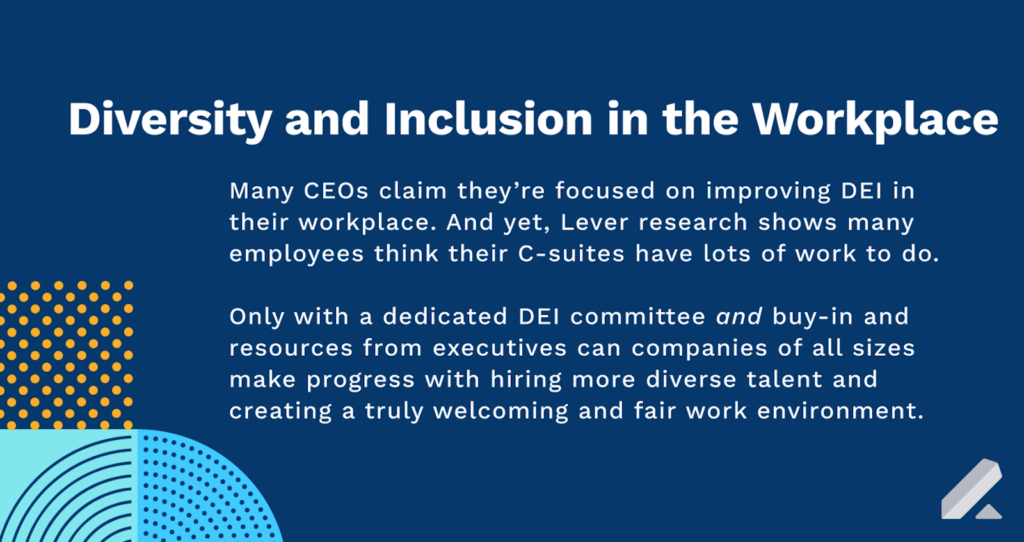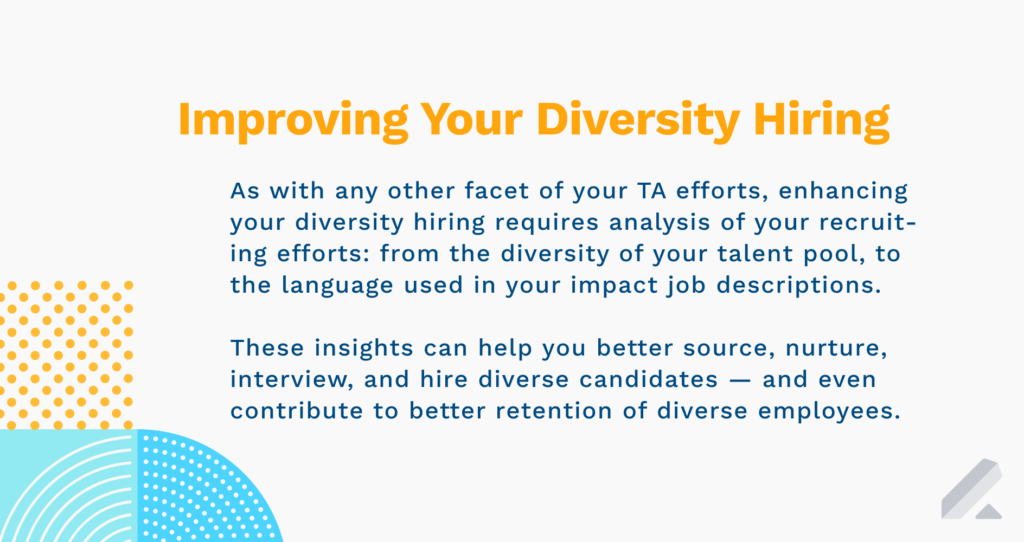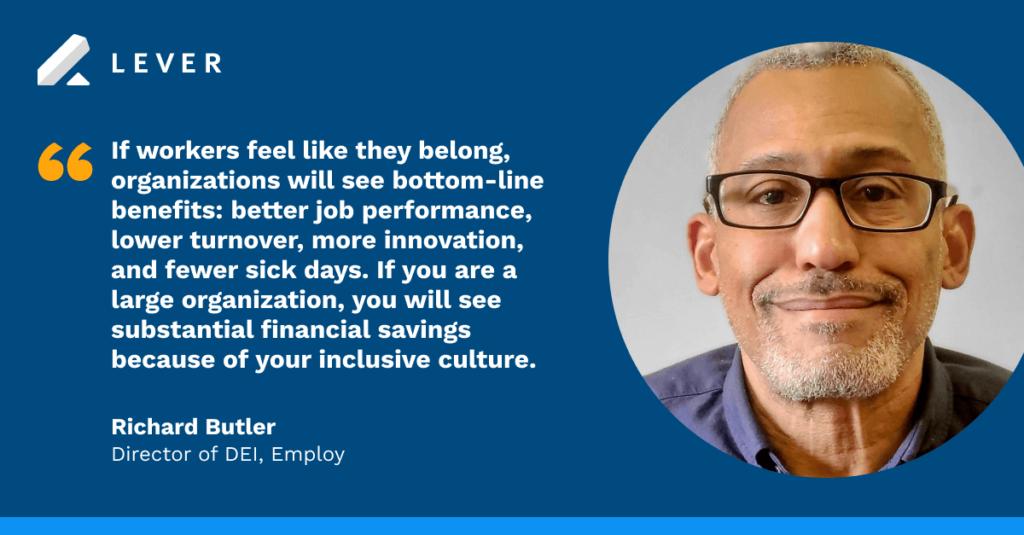Improving diversity and inclusion in the workplace is hard work for business leaders.
But, having grown a team that recently hit a 50:50 gender ratio (an uncommon feat these days, especially in Silicon Valley), we can let everyone in on a secret: It’s not rocket science, either.
“[Diversity, equity, and inclusion] is everyone’s responsibility, not just HR,” Employ SVP Customer Retention & Growth Jessica Green recently shared with StrategicCHRO360.
“Leaders need to show consistency in their commitment. While HR can drive programs and policies, they cannot be the only ones pulling the company along when it comes to DEI progress.
The key is simply starting your commitment to diversity and inclusion efforts. And the earlier the better, to ensure you realize your desired level of impact on your org — including the hiring of groups of people of different races, ethnicities, genders, sexual orientations, and other traits.
Why? Because the longer your org waits to build a more diverse and inclusive workforce, the longer it will take to create a diverse and inclusive workplace culture that helps you both attract and retain top talent and, in turn, achieve your company’s target business and distinct growth goals.

20+ ways to improve diversity and inclusion in the workplace (and enhance the employee experience)
So much of what it takes to cultivate a diverse and inclusive workplace is about approaching tasks every business has to do anyway but in a thoughtful and deliberate way.
“Cultivating a learning orientation toward diversity [in the workplace] … enables companies to increase their effectiveness,” contributor Robin J. Ely and David A. Thomas recently wrote for Harvard Business Review.
Forbes Communication Council member Bernard Tynes shared a similar sentiment.
“Having a diverse workforce means happier and healthier employees, customers feel more respected and managers have greater access to the talent and skillsets they need for their organizations to thrive,” Bernard wrote for Forbes.
Here’s what we’ve done — and what you can too — to boost diversity and inclusion in the workplace, elevate your business performance, and make strides with achieving your company’s respective diversity and inclusion initiatives.

1) Convert all job descriptions to using gender-neutral language. Audit all of your JDs to check for any use of binary pronounces as a default and convert them to gender-neutral pronouns. Truly inclusive companies eliminate exclusive language from all brand copy.
“An inclusive job description is about more than avoiding certain terms,” human resources expert Natasha Nicholson wrote for HRMorning. “It’s about conveying meaning and intent. What you say in a job description will reflect your driving values as an organization.
2) State your commitment to building a diverse and inclusive culture. Share your org’s DEI mission statement in impact job descriptions and on your careers page. Spotlight work you’ve done to embrace diversity and inclusion. Note how you plan to increase the diversity makeup of specific teams across your business that have been historically homogeneous.
3) Write results-based job descriptions. Studies show men apply for a job when they meet some qualifications, but women will only apply when they meet most or all of them. Instead of writing a checklist of skills, focus on the impact a desired candidate is expected to have.
4) Diversify your pipeline by diversifying your sourcing. Go beyond “obvious” sources. Explore online and in-person communities and events where people of diverse backgrounds are.
5) Conduct blind screenings to minimize unconscious bias. Research shows people with ethnic names (particularly women) need to send several resumes to get a single call-back.
“One way to attract diverse talent is to remove demographic indicators from resumes or application materials,” former Gartner Sr. Marketing Program Manager Jordan Bryan wrote. “It might be a name that is an indicator of a person’s gender or a person’s ethnicity. Instead, focus on the skills they have and the work they’ve done.”

6) Ban “culture fit” as a reason for rejecting a candidate. Doing this means unconscious bias is at play in your hiring process. Challenge your interview panelists to articulate a more specific explanation. It’s a great way to uncover hidden biases and work to eliminate them.
7) Request a diverse range of referrals. Note to employees that diversity requires deliberate effort and they can help by making intros to diverse talent in their own networks.
8) Invest in a structured-interviewing process and training. This isn’t to say you must stick to a strict script in interviews. Candidates often share important insights when convos flow naturally. But, structured interviews lead to higher-quality hires because they help reduce bias and “instincts-based” hiring decision-making.
9) Ensure underrepresented employees are interviewers. But don’t over-feature them. As much as job candidates want to meet with a diverse array of faces in chats with potential coworkers, if your one female engineer is in every single interview cycle, it’s not fair to her.
“Ensuring the candidates are reflected on interview panels will also likely increase offer acceptance and send a message that your organization is one in which they can succeed,” Meytier Founder and CEO Rena Nigam recently wrote for HR Daily Advisor.
10) Introduce diversity and inclusion early in onboarding. At Lever, we deliberately exclude any kind of “teaching” during onboarding, like defining privilege, dropping a bunch of stats, or talking about the latest diversity and inclusion issues in tech. Instead, we communicate why Lever cares about DEI and explain how we define it.

11) Catch gendered language in team communications. Alex is an open-source tool you can install wherever you do text editing (like Chrome or Slack). It will catch potentially hurtful language and nicely remind individuals how they can/should rephrase messages.
12) Create a DEI channel in your company’s primary comms tool. At Lever, we have a Slack channel called “#inclusion.” Employees share DEI news and trends. Make it known company-wide your channel exists to empower employees to discuss all-things diversity and inclusion in the workplace.
13) Celebrate holidays and events for underrepresented minorities. Black History Month, Gay Pride Month, Gender Equality Month, World Braille Day: There are many special days, weeks, and months your company can recognize to make people feel recognized and seen.
That being said, you don’t need an official holiday to celebrate diversity, equity, and inclusion in the workplace today, as DEI consultant Nani Vishwanath wrote for HBR.
“A better approach to recognizing and celebrating cultural moments steps away from the calendar,” said Nani. “It’s okay if your organization wants to acknowledge Juneteenth or celebrate Pride month, but you need to make sure you’ve done the work ahead of time to make your contribution is not just un-embarrassing, but more importantly, that it’s authentic,”
14) Recognize when employees do go above and beyond with work. Contributing to your workplace isn’t just hitting sales goals or shipping product. It’s also doing your part to make your company a great place to work, and it deserves props too.

15) Start an employee resource group (ERG). Lever’s ERGs include Leverettes (for female employees) and LeverHues (for LGBT employees). These forums enable open discussion, learning, and support and provide a powerful form of employee engagement.
16) Order a set of knowledge cards. It can be hard to know how to talk about DEI and bring awareness to your coworkers. The Society of Women’s Engineers partnered with Arup to create a set of knowledge cards designed to facilitate a discussion and prompt reflection around DEI to help brands transform into truly diverse companies.
17) Have employees take an Implicit Association Test. This assessment can help your staff acknowledge biases they have. It’s widely considered a vital first step of deeper DEI convos.
18) Print inclusive bathroom signs. Having your office bathroom doors say, “For those who identify as,” above the both the traditional men’s and women’s signs is an excellent way to promote inclusion in the workplace and help non-binary employees feel safe.
19) Establish a mother’s room. This is a place in your office where nursing women have a private space for pumping breast milk. If you’re strapped for space, convert a conference room.
Bigger picture, it’s well past time for C-suites to prioritize a welcoming work environment for working moms, according to Gallup Director of Client Experience Courtney Hesselbacher.
“Cultivate a culture that helps mothers reintegrate into the workplace, claim their identity as a working parent, and chart renewed visions for career advancement,” said Courtney.

20) Hold an international foods potluck. This is a premier way to appreciate the different cultures present in your employee population and open up organic, insightful discussions.
21) Revamp your careers page visuals. What demographics are represented in your photos? In your leadership bios? Candidates can interpret a non-diverse careers page as a sign of a non-inclusive workplace. And that means you lose out on top talent more frequently.
22) Invite a guest speaker from the DEI community to speak at your company. If you already have regular tech and leadership talks, just set aside a couple of slots for DEI as well.
23) Have a parental leave policy. There are dozens of companies with strong parental leave models you can use as a helpful blueprint for your company’s own approach.
24) Hold office hours to hear from your staff. If your HR team has the bandwidth, it can host recurring office hours and welcome input around DEI (e.g., chat with employees about gender diversity-related concerns).
Watch our webinar on globally inclusive recruiting to get insights from HR experts on what you can do to improve inclusion in the workplace and make employees feel included.



